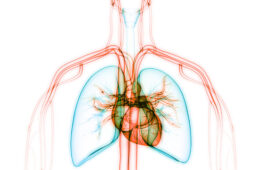 Small molecule drug developer Aria Pharmaceuticals (Palo Alto, Calif.) recently revealed that two investigational treatments for idiopathic pulmonary fibrosis (IPF), TXR-1002 and TXR-1007, demonstrated promising results in preclinical research.
Small molecule drug developer Aria Pharmaceuticals (Palo Alto, Calif.) recently revealed that two investigational treatments for idiopathic pulmonary fibrosis (IPF), TXR-1002 and TXR-1007, demonstrated promising results in preclinical research.
There are currently only two FDA-approved treatments for IPF on the market — nintedanib (Ofev) from Boehringer Ingelheim and pirfenidone (Esbriet) from Roche. While those introductions marked a turning point in treating IPF, managing the disease remains challenging for many patients.
Both TXR-1002 and TXR-1007 rely on a mechanism of action that is distinct from that of nintedanib or pirfenidone. And Aria reports that preclinical testing indicated that the drugs were well tolerated. “Certainly, you can’t tell if a rat is suffering from nausea or something like that, but at a gross level, the animals did well through the course of the study,” said Mark Eller, senior vice president, R&D at Aria Pharmaceuticals. “We’re optimistic based on the mechanism and the data that we’ve collected so far that we’re onto something.”
In general, it can be challenging to develop drugs for idiopathic pulmonary fibrosis, given its unclear etiology.

Mark Eller
“It’s hard to say that any given animal model is really good for something that’s idiopathic,” Eller acknowledged. But the animal model Aria used is “sort of the gold standard” and “was used for both nintedanib and pirfenidone.”
The model considers both inflammation and fibrosis. TXR-1002 and TXR-1007 fared well in both respects.
The company plans to conduct further testing on the two drug candidates.
The preclinical research indicates that the drug candidates have significant efficacy in reducing lung collagen and the infiltration of neutrophils and lymphocytes in the lung, which are markers for inflammation.
“Usually, it’s the inflammation that comes first, and then the fibrosis follows that,” Eller said. Thus, Aria’s model was focused on quantifying lung damage associated with fibrosis. In that respect, the company had “statistically significant results — in fact, numerically superior to nintedanib for lung collagen, which is a fibrosis marker.”
Eller said that the reductions in neutrophils and lymphocytes were not statistically significant. “That’s probably due to the timing,” he said. Because inflammation precedes fibrosis, the company could potentially measure both variables at various times to get a clearer picture of how the investigational drugs impact both factors.
The prevalence of IPF appears to have risen in recent decades, according to a 2018 paper published in Medical Sciences. In addition, the ongoing pandemic and factors such as rampant wildfires could heighten the need for new IPF treatments. Researchers have also identified that certain occupations such as firefighting may elevate the risk for interstitial lung diseases, including IPF. “It is an important area for continued research on the part of the pharmaceutical industry,” Eller concluded.
Filed Under: Pulmonology





Tell Us What You Think!
You must be logged in to post a comment.